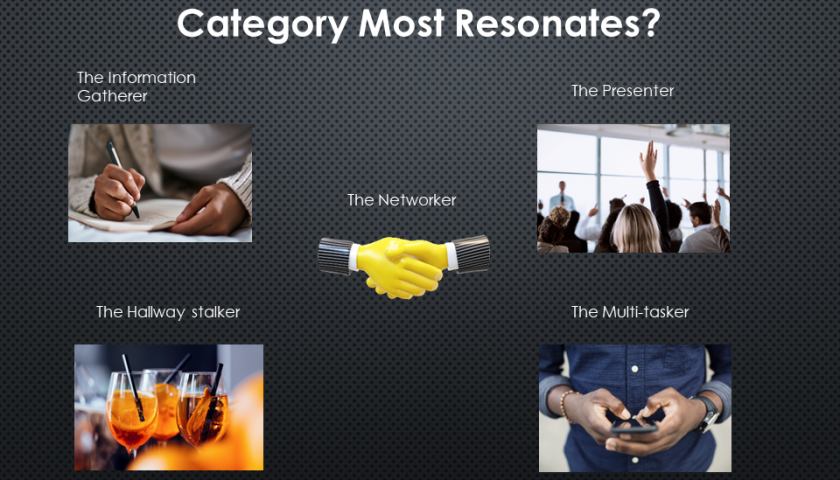With the COVID quarantine near the rear-view mirror, professionals are re-emerging out in public forums to learn, engage and grow their network. Over the years, I’ve witnessed different character types at conferences and events and categorized the most prevalent. Which conference attendee caricature most resonates?
The Information Gatherer. A person who is there for the content, asking questions, taking notes, and highlighting key words or themes that will be incorporated in a future proposal. This is a key element to align resources with need. This person tends to arrive just before the content is presented and leave immediately after the speaker ends.
The Hallway Stalker. A person who is there to see and be seen in the hallway, exhibit halls, restaurants, and bars. This person cares less about the content of the conference and more about scheduling side meetings with current and future strategic partners and customers. This is a key element in strengthening and growing relationships, partnerships, and insider information but lack the intel to connect mission with capabilities.
The Presenter. A person who is selling a product, service, concept, or idea. This person is considered a subject matter expert and has the company’s elevator pitch memorized and ready to recite at any given opportunity. This is a key element to strengthen a company’s brand. This person may be restricted from roaming and freelance networking.
The Multi-Tasker. Attends sessions but also keeps keen attention on emails, current deadlines, and outside meetings. This is a key element to ensure current deadlines and commitments are not missed. Unique conference opportunities may be lost due to divided attention, however.
The Networker. A person who is considered a “generalist”. A person who employs what comes naturally and learns to incorporate the traits that do not. This person may not be able to address technical questions or engage in strategic conversations, however.
When a company wants to attend an event, are the desired outcomes aligned with the strengths/character traits of the employee(s) they want to send?
Are you expecting a hallway stalker to report back and analyze on the content at the caliber that an information gatherer would? Are you asking an information gatherer to sell your product, service, concept or idea as proficiently as a presenter? Are you expecting a networker to be a subject matter expert?
Who and How Many Do You Send to a Conference?
Attending events and conferences is a time and financial commitment. Thoughtful consideration and investment need to be part of the engagement and branding strategy. Desired outcomes should be articulated to determine who and how many should attend.
Once you’ve identified your target customers and the conferences that align, the discussion begins on what to attend and how to afford the expense. The desire may be to send multiple people from your company to engage, but budget and resource constraints may not support. Some suggestions:
- Become an exhibitor. Many conferences will provide additional conference entrance fees for exhibitors. Small Business rates may provide the window of opportunity to send your presenters, hallway stalkers, networkers, etc. at an affordable rate.
- Become a sponsor. If you don’t have the resources to staff an exhibit booth, become a sponsor for branding awareness and the flexibility to attend sessions, stalk the hallways and attend sponsor-specific networking events. Small business sponsorships usually come with 2 or more conference entrance tickets. Don’t be shy. Negotiate!
- Submit to a white paper contest. Many of the larger conferences have a call for white papers 6-9 months prior to the conference. These submissions are based on problem statements identified by the customer. There may be a submission or exhibit fee, but if you’re chosen, the branding opportunity to present to your target audience could be time and money well spent.
- Become a volunteer. Multi-day conferences are labor intensive. Non-profits such as AFCEA, rely on volunteers to support registration, sessions, etc. Depending on the conference, 4 – 8 hours of volunteer service will provide a complimentary conference ticket. This option may be particularly attractive to your seasoned networker or hallway stalker.
- Pro-tip: For multi-day conferences, sharing conference tickets may be a way to get your presenter to attend on day 1; your hallway stalker on day 2 and your information gatherer on day 3. Sometimes this is allowed, but sometimes it is not. It’s worth a creative conversation with the conference host.
Who and How Many Do You Send to a Conference? As with most leading questions, the answer is, “it depends.” The take-away is to be thoughtful about the decision. Non-profits such as AFCEA have corporate professionals to help large, medium and small businesses create a branding and engagement strategy that meets business goals and budgets. With AFCEA, there’s a marketing arm that works with companies to create a multi-pronged branding strategy to reach customers in the C5ISR and Intelligence arenas.
If you’d prefer an outside resource to help you navigate the event / conference landscape, Mild Red, LLC supports businesses in navigating the GOVCON arena in four key areas:
- Past Performance Templates
- Business Strategy
- Networking
- Corporate Branding
It’s time to re-allocate dollars back in marketing and branding to engage, network and grow. There’s help out there if you want it. See you on the outside!

